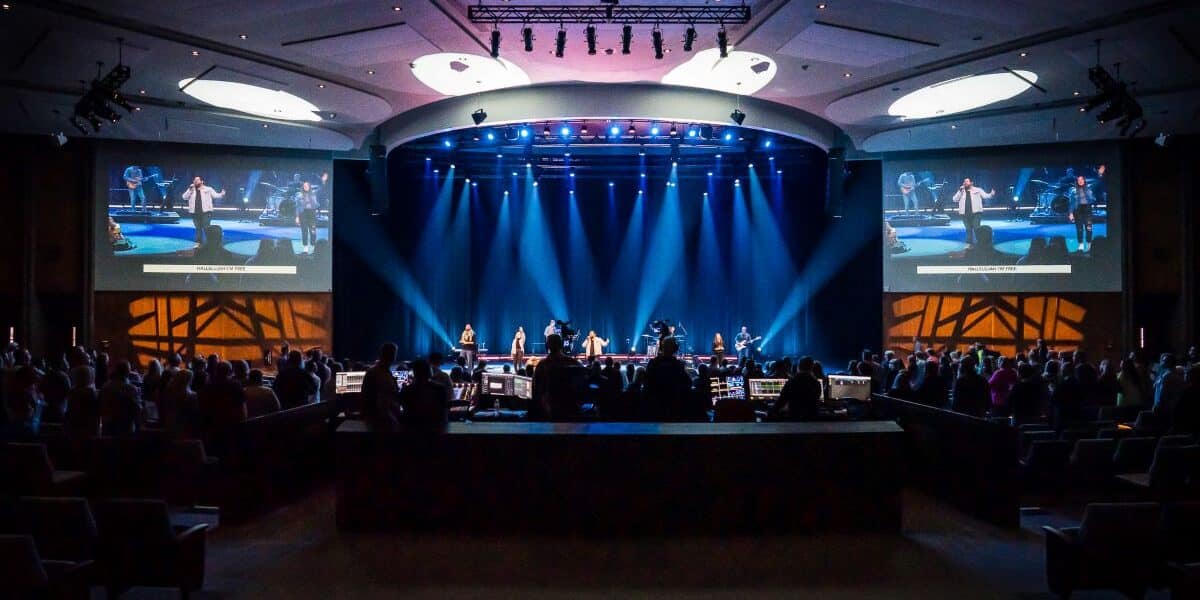You’ve probably heard the term “immersive audio” in relation to elaborate stage productions or large-scale venues like the Las Vegas Sphere.
However, this technology is not just for artistic purposes or limited to exclusive venues. Immersive audio is scalable, accessible, and useful to venues of all types.
Let’s look at immersive audio and how it can be relevant in worship spaces.
What Is Immersive Audio?
Traditional systems focus on amplifying and distributing sound from a source on a stage into the audience. In contrast, immersive audio aims to present the audience with an enveloping sound and music experience. This approach is akin to surround sound and cinematic audio familiar to audiences in movie theaters and home entertainment settings.
In houses of worship, immersive audio elevates the congregational experience, making it more engaging and interactive. Instead of just hearing music or words from the front of the room, the sound wraps around you, making you feel like you’re a part of the worship experience.
This immersive effect helps everyone to feel more connected and a part of what’s happening. It’s a way to make services more interactive and exciting, letting you not just hear, but really feel yourself engaging as a participant of the music and spoken word.
Types of Immersive Audio and Their Uses
Two primary types of immersive audio processing technologies for live venues are active acoustics and object-based mixing.
Active Acoustics
Active acoustics considers the existing architecture of a venue and uses specialized audio processing to change the perception of the reflective properties of the room through a distributed loudspeaker system. This can make a contemporary worship space sound like a gothic cathedral or an auditorium sound like a concert hall.
One of the advantages of active acoustics is the ability to turn a single-purpose space into a multipurpose space. Many traditional and blended churches perform contemporary music, traditional music or a mix of both. These venues tend to have traditional architecture and can be more reverberant, so acoustical changes might be necessary to make it appropriate for multiple uses.
With active acoustics, a room can be changed dynamically to optimize the audio for a contemporary band, choir, or speech. By using electronics to vary the perceived acoustics and the timbre of the sound, the reverberant character of the room can match the performance, leading to improved musicality, intelligibility, and greater audience engagement.
Object-Based Mixing
Object-based mixing can help virtually separate the instruments on a stage so you can hear more sonic detail. This is especially beneficial in a complex mix. Many contemporary worship bands have layered and dense musical styles, so the ability to spatially separate instruments into a wider sound field allows the audience to hear all the individual parts more clearly. Instead of just a left-right “2D” stereo image, the audience is now fully immersed in a multidimensional spatial audio experience.
Additionally, object-based mixing can make the sound mixer’s job easier. Their task is to blend all these sounds in a way that’s not only pleasing to the ear, but also presented in a clear and distinct manner. When they can place each instrument, voice or sonic element in its own space, it’s easier to make each part stand out clearly.
Cost of Entry
Immersive systems do not necessarily require large concert-grade line array systems. The overall investment depends on the scale of the system and the desired immersive capabilities. Immersive audio for a 3,000-seat auditorium will look very different than for a 200-seat worship space.
An easy way to make an immersive system more affordable is to combine reinforcement system processing with immersive audio processing. These comprehensive processors can be installed with a new sound system or can be efficiently retrofitted into an existing distributed loudspeaker system. As immersive audio technology continues to develop, it will become more affordable and accessible to venues of all types.
Examples
There are many use cases for immersive audio in worship spaces but here are two examples:
Bethany First Church of the Nazarene − Bethany, OK
Bethany First Church is a 1,650-seat mid-century modern auditorium with a permanently installed pipe organ. This church runs services with three different types of music. Active acoustics are used to tailor the acoustics of the space to match the unique sonic needs of each musical style.
Their first service type contains contemporary pop-rock music, so the acoustics are adjusted to a more natural state where the auditorium feels less reverberant. In this service, we hear a very tight band sound without excessive room reverberation muddying the more modern music experience.
In the second service type, Bethany presents traditional music with a full choir, orchestral instruments and a pipe organ. Active acoustics are used to increase the overall reverberant sound field. In this service, we experience a reverberant space that more closely resembles a traditional concert hall, supporting the orchestra and organ with longer reverberation times.
In the third service type, we simultaneously have both styles of music playing, where one song may lean towards being more rock band driven, while the next may be more instrumentally and vocally traditional. In this service type, active acoustics are used to augment the natural acoustics of the auditorium and are dynamically changed throughout the event. This allows Bethany to place the traditional instruments and voices in a more reverberant environment, like a cathedral, while keeping the rock band in the naturally less reverberant auditorium.
The ability to change acoustics dynamically is something you can’t do with physical architecture. With active acoustics, Bethany has a versatile acoustical space that allows them to seamlessly merge many different styles of worship in the same service.
Church of the Highlands – Birmingham, AL
Church of the Highlands has a vocal-forward, high-energy, modern worship experience. Their large, 2,500-seat worship center was originally built to be acoustically “dry.” When Highlands renovated the room in the year 2020, the primary goal was to create an acoustically immersive space where the congregation was fully engaged in the worship experience.
The pairing of passive acoustics and active acoustics allowed them to create a unique environment that engages the listener as active participants in worship. These additions helped to increase audience participation and added a sense of a personal connection during congregational worship that was not possible in the original, “dry” room.
Immersive audio can be a helpful tool in improving the acoustics and overall audience experience in worship environments. The technologies can be scaled into different sizes and types of venues.
As immersive audio technologies continue to develop, we expect to see them become increasingly cost-effective and be implemented into more house of worship environments.
This information is courtesy of Fulcrum Immersive, which specializes in multi-channel immersive audio solutions for performance environments, www.fulcrum-immersive.com. Its hardware and software tools enable the design, deployment and operation of scalable sound systems to enhance the listening experience and improve audience engagement.












